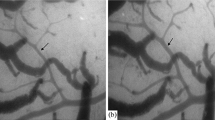Abstract
These studies were undertaken to determine the effect of reducing aPCO2 below physiological levels on cat middle cerebral artery. Upon reduction ofPCO2 from 37 to 14 torr (pH 7.4) we observed membrane depolarization and force development. ReducingPCO2 decreased the slope of theE m vs. log [K]o curve and increased the slope of the steady-state I/V relationship suggesting that the change inE m was due to reduction of outward K+ conductance (g k). Elevation of pH from 7.37 to 7.6 had a very similar effect on these cerebral arterial muscle cells, depolarizing the muscle membrane (reducing theE m vs. log [K]o curve) and increasing the slope of the I/V relationship to statistically equivalent values as reduction ofPCO2. ReturningPCO2 from 14 to 37 torr rapidly relaxed these preparations, but only transiently. This relaxation was followed by a rebound contraction within 3 min, demonstrating a transient nature for the action of elevatingPCO2 in cerebral arteries. The response to changing pHo followed a slower time course but did not change with time. These studies demonstrate that both elevated pHo and reducedPCO2 activate cerebral arterial muscle by a mechanism which includes reduction ing k. However, it can not be determined if these similar responses and reduction, ofg k are mediated by changing pHi or mediated through different mechanisms. It is possible that pHo andPCO2 can modify cerebral arterial tone by direct mechanisms and not necesarily by their effect on pHi. It is clear, however, that reduction ofPCO2 and elevation of pHo both activate cerebral arterial muscle by a mechanism which includes reduction ofg k.
Similar content being viewed by others
References
Abe Y, Tomita T (1968) Cable properties of smooth muscle. J Physiol 196:87–100
Ahmid, Z, Connor JA (1980) Intracellular pH changes induced by Ca2+ influx during electrical activity in molluscan neurons. J Gen Physiol 75:403–426
Aickin C (1984) Direct measurement of intracellular pH and buffering power in smooth muscle cells of guinea-pig vas deferens. J Physiol 349:571–585
Aickin C, Thomas RC (1977) Microelectrode measurement of the intracellular pH and buffering power of mouse soleus fibers. J Physiol 267:791–810
Allen DG, Orchard CH (1983) The effects of changes of pH on intracellular calcium transients in mammalian cardiac muscle. J Physiol 335:555–568
Baker PF, Honergager P (1978) Influence of carbon dioxide on level of ionized calcium in squid axons. Nature 273:313–333
Casteels R, Kitamura K, Kuriyama H, Suzuki H (1977) The membrane properties of the smooth muscle cells of the rabbit main pulmonary artery. J Physiol 271:41–61
Ellis D, Thomas RC (1976) Intracellular pH of mammalian cardiac muscle. J Physiol 262:755–771
Harder DR (1983) Effect of H+ and elevatedPCO2 on membrane electrical properties of cat cerebral arteries. Pflügers Arch 349:182–185
Harder DR (1983) Heterogenecity of membrane properties in vascular muscle cells from various vascular beds. Fed Proc 42:103–107
Harder DR (1980) Membrane electrical effects of histamine on vascular smooth muscle of canine coronary artery. Circ Res 46:372–377
Harder DR, Sperelakis N (1978) Membrane electrical properties of vascular smooth muscle from guinea-pig superior mesenteric artery. Pflügers Arch 378:111–122
Isenberg G (1977) Cardiac purkinje fibers: [Ca]i controls steadystate K+ conductance. Pflügers Arch 371:71–76
Lassen N (1968) Brain extracellular pH: the main factor in controlling cerebral blood flow. Scan J Lab Invest 22:247–251
Lea TS, Ashley CC (1978) Increase in free Ca2+ in muscle after exposure to CO2. Nature 275:236–238
Meech RW (1974) The sensitivity of helix asperso neurons to injected Ca2+ ions. J Physiol 237:257–277
Author information
Authors and Affiliations
Additional information
This study was supported by NIH grant no. HL-32871. Dr. Harder is an established investigator of the American Heart Association
Rights and permissions
About this article
Cite this article
Harder, D.R., Madden, J.A. Cellular mechanism of force development in cat middle cerebral artery by reducedPCO2 . Pflugers Arch. 403, 402–406 (1985). https://doi.org/10.1007/BF00589253
Received:
Accepted:
Issue Date:
DOI: https://doi.org/10.1007/BF00589253




